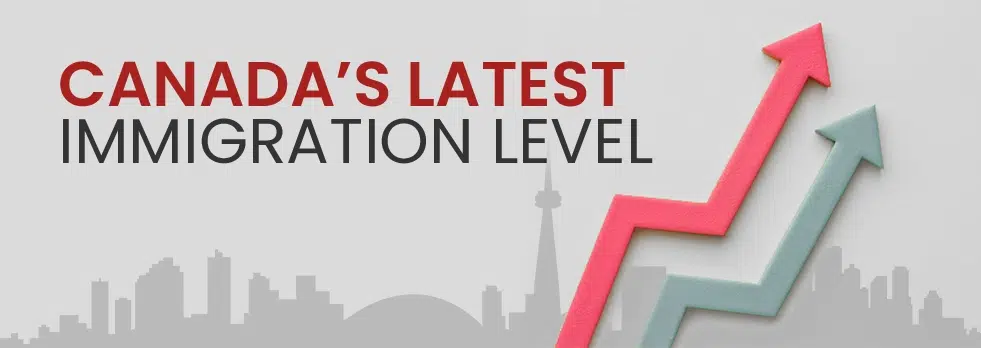
Canada’s Latest Immigration Level 2023-2025
The Canada Immigration Levels Plan for 2023–2025 is a crucial policy document that describes the nation’s strategy for immigration over the following three years. The Canada Immigration Levels plan, which was unveiled by the Canadian government in November 2022, outlines the government’s goals for both the quantity and nature of immigrants it wants to move to canada.
In this post, we’ll take a closer look at Canada’s Immigration Levels Plan for 2023–2025, going over its main components, objectives, and potential effects on the social and economic climate of the nation.
Let’s first take a moment to review the larger context of Canada’s immigration policy before diving deep into the minute details of the 2023–2025 immigration plan. Canada has a long history of opening its doors to immigrants from all across the globe and is now regarded as one of the most hospitable and immigrant-friendly nations in the world. To quantity over 400,000 new immigrants have moved to Canada in 2021 alone, a figure that reflects the nation’s commitment to diversity, inclusivity, and economic growth.
Canada’s immigration levels plan for 2023 to 2025 showcases the government’s target for the number of immigrants it plans to welcome and accommodate to the country over the next three years.
Canada aims to welcome the below-mentioned number of residents in the immigration-level plan.
| Year | Immigration level plan |
| 2023 | 410000-505000 |
| 2024 | 430000-542500 |
| 2025 | 442500-550000 |
The plan also includes a breakup of the immigrants that Canada plans to accept. The majority of new permanent residents in canada as per the immigration plan will be economic immigrants, including skilled workers, entrepreneurs, and investors which by the way will give a huge number of Work Visa, Study Visa and probably Startup Visa to Canadian Immigration application for permanent residency in canada who will be moving to canada. The plan includes family reunification, refugees, and humanitarian ground immigration cases.
Building on this custom, the Immigration Levels Plan(1) for 2023–2025 outlines the government’s objectives for the number and types of immigrants it hopes to bring to the country over the next three years. The plan is created to strike a balance between economic, family, and refugee/humanitarian immigration in order to ensure that Canada continues to welcome a wide variety of people who can contribute to the social and economic well-being of the country.
features of Canada’s latest immigration level plan for 2023-2025
Mentioned below here are some of the key features of Canada’s latest immigration level plan for 2023-2025:
Higher Immigration Target:
The plan’s lofty immigration goals are arguably its most important aspect. Canada expects to accept over 1.2 million new immigrants over the next three years, up from the 401,000 intended in 2021. With a focus on industries like healthcare, technology, and skilled trades, this increase is intended to address labour market shortages and promote economic expansion.
Focus on Economic Immigrants:
The plan puts a lot of effort into luring in economic immigrants, especially those with qualifications and experience that are highly sought after in the Canadian labour market. With a target of 470,000 economic immigrants by 2025, the government intends to increase the number of economic immigrants it admits each year.
Family Immigration:
The government has pledged to maintain levels of family immigration, which includes the sponsorship of spouses, partners, children, parents, and grandparents, even though economic immigration is a major focus of the plan. The plan aims to accept 103,000 family immigrants annually.
Refugee and humanitarian immigration:
The immigration plan also included Refugee and humanitarian immigration in the plan, with a target admission rate of 3500 protected individuals (such as asylum seekers and stateless people) and 22,500 refugees annually. These goals are a reflection of Canada’s ongoing humanitarianism and commitment to giving those in need a safe haven.
Immigration of French Speakers:
The plan includes goals for the immigration of French Speaking nationals as part of its initiatives to support and encourage bilingualism throughout the nation. A significant increase from the 4,000 targets set in the past years, the government plans to accept 13,500 immigrants annually who speak French.
Flexible immigration routes:
The plan emphasises the significance of adaptable immigration ways that can adapt to shifting social and economic circumstances. This includes implementing pilot projects, creating temporary immigration streams, and modifying immigration levels to address changing labour market demands.
Reasons for Canada’s High Immigration Levels
For many years, immigrants have been welcomed with open arms in Canada. Immigration is a major force behind economic expansion and a solution to the nation’s demographic problems. Canada is the most preferred destination for work Visa as well as Study visa for Canadian Citizenship. Some of the primary causes of Canada’s high immigration levels are as follows:
Economic Growth:
The ageing population and falling birth rate in Canada have led to a shrinking workforce, which could have long-term negative effects on the economy. Immigration is thought to be a solution to this problem because it can attract new entrepreneurs and workers who can spur economic growth.
Diversity:
Canada is a multicultural nation with a rich history. Bringing in individuals from various nations and backgrounds is seen as a way to preserve and enhance this diversity.
A key component of Canada’s immigration policy is family reunification. Many Canadians have relatives who reside outside of their country, and immigration enables them to connect with these family members.
Refugees Resettlement:
Canada has a history of supporting this effort and is regarded as a pioneer in it. Canada can offer asylum to people escaping war and persecution thanks to immigration
Why expect higher Canadian immigration targets?
As told by Mr. Sean Fraser in a press conference “Look, folks, it’s simple to me. Canada needs more people” Canada’s Minister of Immigration, Refugees, and Citizenship Canada (IRCC).
In the past, Canada has accepted a large number of immigrants to move to Canada to “support & sustain” its economy. Canada is currently dealing with severe labour shortages and nearly 1 million open positions. The higher immigration targets are the result of both. Statistics show that the 1 million job vacancy shortage was over 80% above pre-pandemic levels and an increase of 2.7% from the previous peak in the last quarter. In recent years, this has been the highest recorded value. In many industries across the nation, there are more open positions than there were a year ago. The healthcare and social assistance industries are some of the most severely impacted. The ageing population and post-pandemic conditions have caused a sharp increase in the demand for professionals in these fields. Canada is looking forward to allowing immigrants via different channels available for immigration be it via a work visa, study visa or even it can be a Canada startup visa programme for permanent residency in Canada.
Potential Impact of Canada’s Immigration Levels Plan
The immigration levels plan for Canada for 2023 to 2025 has the potential to have a huge impact on the economy and society of the nation. A few of the plan’s potential effects include the following:
Economic Growth:
Immigration is anticipated to play a significant role in Canada’s economic growth over the coming years. The influx of new employees and business owners is anticipated to generate new employment opportunities and stimulate innovation, which may result in higher productivity and economic prosperity.
Labour Market issue:
The plan is anticipated to assist in addressing labour shortages in important industries like healthcare, technology, and construction. This might result in better infrastructure and services for Canadians.
Population stability:
Immigration is anticipated to be the main factor driving Canada’s population growth over the coming years. Expanding the workforce and fostering economic growth, this could aid in addressing the demographic issues facing the nation.
Social integration:
Immigration may have both favourable and unfavourable effects on social cohesion. Immigration can contribute to maintaining and enhancing diversity, but if it is not properly managed, it can also cause social tensions. The Canadian government will have to see to it that immigrants are assimilated into society and have access to the tools they require to be successful.
Current challenges in Canada’s Immigration Plan for 2023-2025:
Although Canada’s plan to increase immigration levels from 2023 to 2025 has the potential to have a lot of positive effects, there are also difficulties and factors that must be taken into account. The following are a few of the challenges and things to think about:
Housing and Infrastructure:
Canada’s housing market and infrastructure may be under pressure as a result of the influx of new immigrants. The Canadian government must make sure there is enough accessible housing and infrastructure to support the influx of newcomers.
Employment:
While it is anticipated that immigration will help address the labour shortages in critical industries, it also has the potential to increase competition for jobs in other industries. Both new immigrants and native Canadians must have access to enough employment opportunities, according to the Canadian government.
Integration:
Language and cultural barriers, as well as a lack of social support networks, may make it difficult for new immigrants to adjust to Canadian society. To assist newcomers in integrating into Canadian society, the Canadian government will need to provide resources and support.
Health:
If there is an increase in demand for healthcare services, the influx of new immigrants may put pressure on Canada’s healthcare system. Both new immigrants and native Canadians will require access to adequate healthcare, so the Canadian government must make sure that this is the case.
Security Issues:
The Canadian government must make sure that immigration regulations don’t jeopardise the country’s security. There is a chance that some people move to Canada and utilize Canadian citizenship to fulfil their ill motives like terrorism or get indulged in criminal activity.
Conclusion
The Canadian immigration application process might seem profuse, but with the guidance and information, you can cruise it smoothly. Whether you’re looking for temporary residency or aiming for Canadian citizenship, understanding the immigration process is very criticial. The country’s commitment to welcoming immigrants and addressing demographic challenges is continued in Canada’s immigration levels plan for 2023 to 2025. The plan prioritises diversity and economic growth while also aiming to maintain high levels of immigration(2). The plan has the potential to have a wide range of positive effects, including increased population growth, social integration, and to mention economic growth resulting due to the immigration level plan. Housing and infrastructure, employment, healthcare, and security issues are just a few of the difficulties and factors that must be taken into account.
The immigration process or the Canada immigration application process has to be robust and sound so that illegal immigrants who wish to move to Canada and get Canadian citizenship are stopped well in advance. From gathering the necessary documents to submitting your Canada immigration application, each step requires attention to detail and adherence to specific requirements. To make sure that its plan to increase immigration levels is successful, the Canadian government must look into these issues diligently so that no issues arise of that sort in the near future as a result of Immigration Plan 2023-2025.
Whether you’re considering temporary residency or aiming for Canadian citizenship, understanding the canada immigration application process is crucial. From gathering the necessary documents to submitting your Canadian Immigration application, each step requires attention to detail and adherence to specific requirements. So, take the first step towards your Canadian dream by exploring the possibilities and starting your Canadian immigration application today.
Why Trust Worldwide Transcripts
Being an authorised and verified source of documents, Worldwide Transcripts has partnered with 12+ evaluation bodies and has been successful in sending verified transcripts to 50+ evaluation bodies abroad. We have been a trusted name in the documentation procurement industry for over 13 years and have ties to more than 800+ universities in verifying and sending credentials electronically within 24 hours to the ECA body or destination of choice.
FAQ's
What is the immigration level strategy for Canada from 2023 to 2025?
The target number of immigrants to be admitted to Canada between 2023 and 2025 is specified in the most recent immigration levels plan for Canada. The plan calls for Canada to welcome more than 400,000 immigrants each year, which would be record-breaking.
How does it differ from previous immigration-level plans?
A unique aspect of this immigration-level plan is that it has established the highest admissions goal in Canadian history. The plan also places a strong emphasis on boosting economic immigration, which includes welcoming more refugees and family members as well as skilled workers and business owners.
Outline a few benefits of increasing immigration levels?
Canada can gain from higher immigration levels in a number of ways. It can support economic growth, promote diversity and multiculturalism in Canadian society, and help with labour shortages.
Under this plan, how will Canada choose its immigrants?
Canada will continue to choose skilled workers and business owners using a points-based system. The system considers elements like education, linguistic ability, work history, and age. In addition, Canada will keep placing a high priority on protecting refugees and reuniting families.
Will the new immigration level plan for 2023-2025 lead to overcrowding?
The goal of Canada’s immigration levels policy is to ensure that immigrants successfully integrate into society and boost the country’s economy. The plan provides resources to support newcomers’ settlement and integration while taking into account the capacity of public services to meet their needs.
How do I submit an application to enter Canada under this scheme?
This is not a different scheme from the ongoing so, for those who want to apply to immigrate to Canada, there are a number of immigration programmes available. These include, among others, the Provincial Nominee Programme, the Canadian Experience Class, and the Federal Skilled Worker Programme. On the official Canadian immigration website, you can find more details.
References
- Immigration Plan: www.canada.ca/en/immigration-refugees-citizenship/corporate/publications-manuals/departmental-plan-2023-2024/departmental-plan.html
- Higher Canadain Immigration plan: https://www.hindustantimes.com/brand-stories/new-canada-immigration-level-plan-2023-2025-released-101669807594526.html







